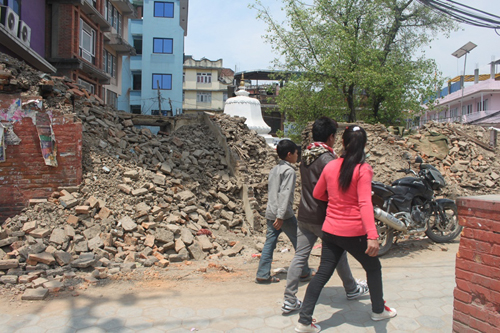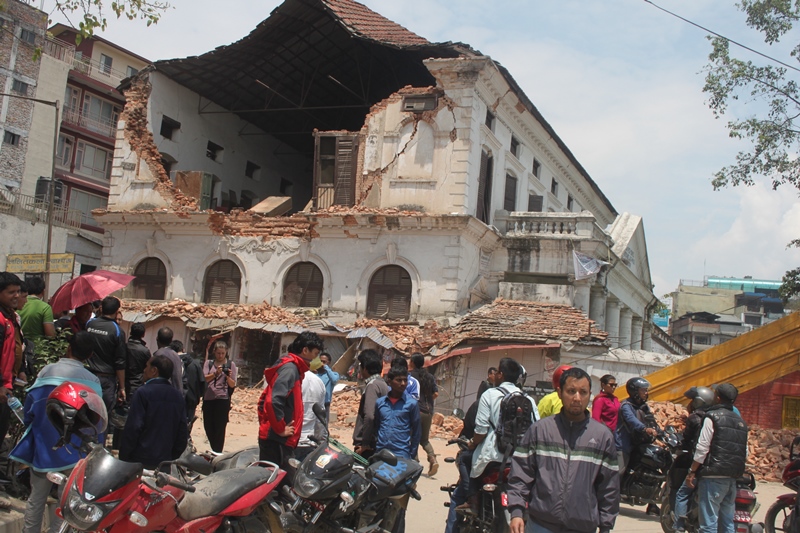The monsoon has started with pouring rain, quake-induced fissures on hills are expanding, roads are getting frequently blocked, hundreds of thousands in Nepal are still living in tents in the areas ravaged by the 7.8 magnitude earthquake on April 25 and the 7.3 aftershock of May 12.
Amidst the urgent need for rehabilitation and reconstruction and fury over inadequate response, Nepal’s government is organizing a donors’ conference on June 25, exactly two months after the quake that left over 8,000 dead and thousands more injured.
A day before the conference, the government said preparations were complete. Senior representatives of finance ministries of Nepal’s two giant neighbours – India and China – are slated to attend. So are film stars Leonardo Dicaprio and Joanna Lumley. So is former US President Jimmy Carter. The organisers said there would be over 200 participants.
But there was still more confusion than clarity over what would come out of the giant exercise, thanks partly to internal conflicts between political parties over the reconstruction plan and partly to the widening gap between donors and the government which now has a policy of channelling all aid through a single door.
The government has released a Post Disaster Needs Assessment (PDNA) that outlines its immediate requirements and has urged donors to put money figures on it to make it work. The document released last week has pointed out that the country needs nearly $7 billion urgently – equivalent to almost a third of its economy. In contrast, figures provided by the UN Humanitarian agency UNOCHA says Nepal has received only about $300 million in the last two months despite big pledges by the global community immediately after the quake.
On June 23, the World Bank said it would provide half a billion dollars for reconstruction. Other donors are expected to come up with figures but many say the problem is not about availability of funds but about procedures on how it will be used and with what degree of transparency.

Conflict between government and donors heightening
The mistrust between donors and the government is increasing – donors see the government system as highly inefficient and corrupt while the government is frustrated over a large chunk of money being spent on administration and expat salaries. Experiences from other disaster-hit countries indicate that the conflict will continue.
Local media have already started digging out government’s irregularities on relief distribution as well as lack of transparency by international NGOs. The government’s anti-corruption bodies and parliamentary committees have started grilling ministers and bureaucrats over alleged irregularities in relief distribution.
The international community’s unhappiness with the single door system to channel relief money meant the Prime Minister’s Relief Fund received only $60 million in the last two months, despite frequent appeals. Many see the donors’ conference as the government’s initiative to reduce conflict as the gap between what is needed and what is available is getting wider by the day. At the same time, ministers say the country will not compromise, though they are willing to listen to what the donors have to say.
No consensus among political parties
Nepal’s council of ministers decided to form a separate agency – to be headed by the Prime Minister – to oversee reconstruction. The President approved the ordinance last week. However frustration and anger over its establishment is already evident – former Prime Minister and Unified Communist Party of Nepal (Maoist) second-in-command Baburam Bhattarai described the committee as a valueless and visionless entity. He is among those who advocated the setting up of a powerful independent agency but finds the current one dominated by bureaucrats and ministers.
Some experts say the government rushed to form the agency to show its seriousness to the international community. They doubt its power to implement anything.
But there are others who see Bhattarai’s comment as personal frustration as he was not allowed to head the agency as he had wanted to do. Responding to that criticism, Bhattarai said on June 23, “I don’t have any attraction towards it (the agency) but we failed to plan and it will not rebuild the devastated country.”
Way forward
Much of the destruction in the quake is due to poor construction. The entire planning system has to be revised from the grassroots upwards to ensure the reconstruction effort comes up with quake-resistant buildings, roads and other infrastructure.
There is no sign of that. Though hopes from the donors’ conference are high, the meeting will not solve the problems of the quake-hit people unless there is a change of attitude on every side.

